Email Templates
How Can I...
- Create an email template
- Organize email templates
- Preview email templates
- View template analytics
- Sort and search email templates
- Working with template folders
- Preview email templates
- Using email templates
Communicating with customers is an important activity in any business scenario. Zoho CRM provides Email Templates to send one message to multiple recipients. Email templates can be used to send a mass Email to leads/contacts, and send Email notifications to the Zoho CRM users upon triggering a workflow rule.
Create an Email Template
To create a new template
- Go to Setup > Customization > Templates > Email.
- Click on the + New Template button.

- Select the module for which the Email template has to be created from the drop-down list and click Next for the Template Gallery page.

You can then proceed to create the template in three different ways:
Creating From Scratch
This makes the creation of mail templates easier. All you have to do is drag and drop components onto the template to create it. An All Component panel will be available when creating a template from which you can drag and drop components. With predefined components the level of customization needed is very little.
After clicking on the + New Template,
- Choose Blank template from the template gallery.
- Drag and drop all the required components from the All Components section onto the template and customize it as needed.
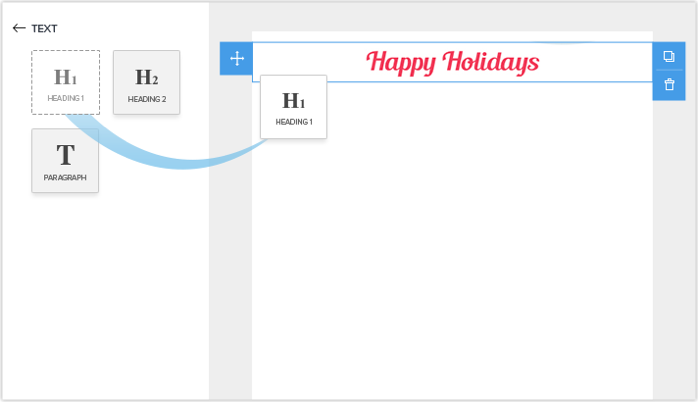
- Mention the Name and the Subject of the template.
- Save the template to the appropriate folder.
- You can then proceed to customize the template using the template builder. Learn more.
Using Predesigned Templates
To make the creation of templates easier, predesigned templates are provided in the template gallery. You can choose any template from the list that fits your needs and customize it using the drag and drop editor. You can preview the template before selecting it. Learn more.
Inserting HTML
- In Zoho CRM, go to Setup > Customization > Template.
- In the Template Gallery click on the Insert HTML code / Plain text link.
- Click on the HTML icon, paste your HTML code and click Insert.
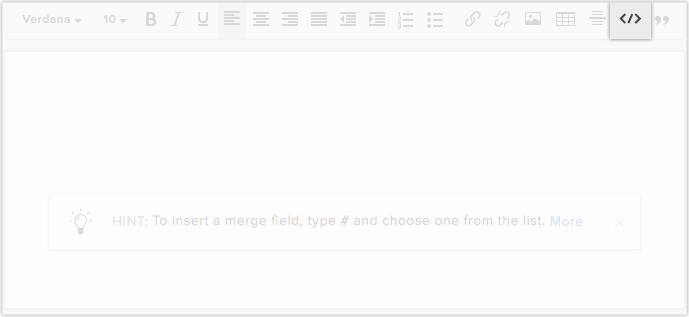
- Click Save.
Sample Email Template
Below is a sample email template that shows how the merge fields retrieve relevant data.
Email Output
Organize Email Templates
Organize your email templates by sorting them into template folders. Preview your email templates before you save them and also view template analytics to see which ones have had better reach.
Preview Email Templates
You can view the preview and the analytics of the template on the list page itself, making it easier for you to view one template after another. With this, you can get an idea of how the template looks and how well it is performing, helping you in deciding if any improvements have to be made.
Delete and move templates
At times you may want to delete templates that are not used much, templates that underperform and junk templates. You can delete a template by selecting it and clicking on the Delete button.
You can move a template from one folder to another. This will be helpful in instances where you have to share a few templates with someone. You can move the needed templates to a folder and share. This can be done by selecting it, clicking on the Move to Folder button and choosing the appropriate folder form the drop-down list. You can also create a new folder and move the template to it if you want.
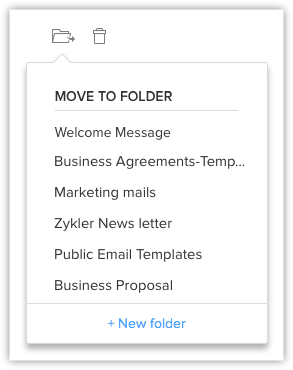
View Template Analytics
With template analysis you can get to know about the performance of each template. Whenever changes are made to the template, it is considered as a new version of the template. This lets you analyse how each version of the template has performed and gives you an idea of how well the implemented changes have been accepted. Know more.
- Go to Setup > Customization >Templates > Email.
- Click on the required email template and select the Analytics tab or you can click on the open rate under the stats column. A graph with the template statistics will be shown.
- You can toggle between:
- Open Rate: Opened rate is the percentage that tells you many times the email containing the template has been opened by the customers.
- Click Rate: Clicked rate is the percentage that tells you how many clicks were registered by the customers for that particular email containing the template.
- Version: The Version tab gives you a list fo when a template was modified and by whom. Click on it to view a summary of the template with details such as different versions, open rate, click rate, when it was done and by whom.
- Open Rate: Opened rate is the percentage that tells you many times the email containing the template has been opened by the customers.
- You can choose to view the graph based on the Percentage, Count or Version from the drop-down list.
- You can choose if you want a specific version or all versions to appear on the graph.
- You can define the range of dates for which the data should appear on the graph.
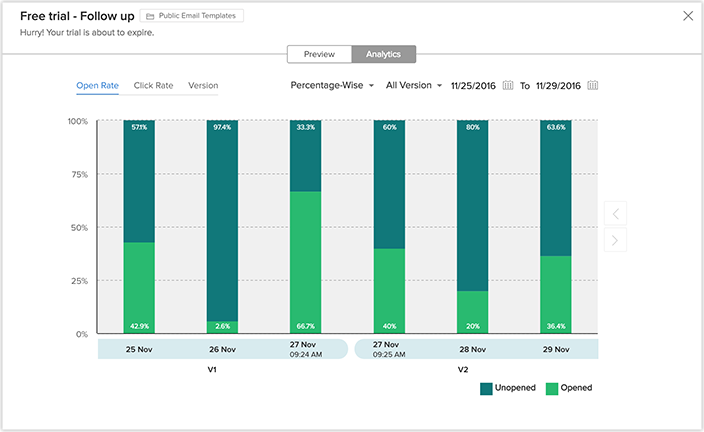
Sort and Search Email Templates
Sorting makes it easier for you to access the templates that you need, by bringing them to the top of the list. For example, you can sort the templates in such a way that the most used templates appear at the top of the list. In Zoho CRM you cannot only sort templates, you can also search for templates.
- You have two options for sorting templates based on time.To sort it based on the last use time, click on the Last Used column. With the help of the Last Used column you can get to know which templates are used the most.To sort the template based on the modified time click on the Modified Time column.
You can also search and filter templates based on your needs.
- You can search for a template by its name with the help of the search bar provided.
- Choose the module from the drop-down list to display the templates related to that particular module.
Clone Email Templates
At times, there might be slight changes that have to be made to the content of an existing template, before sending them to a customer. Rather than having to go through the trouble of creating a whole new template, you can clone the old template, make the necessary changes and send it. To clone a template, select the template and click the clone button that appears on the preview section of the template.

Marking Favourites
You may have templates you frequently use and might want those to appear at the top of the list at places where you select templates. For this purpose you have the option of setting templates as favourite by clicking on the star that appears before the template name.

Associated Templates
At times some templates will be associated with other CRM functions like Workflow, Case Escalation, Macro etc. In these instances, you can view the functions with which the template is associated by clicking on the button that appears at the end of the template details.
You cannot delete a template that is associated with other functions directly. Incase you want to delete it, you have to remove the template from all the places it is associated and then delete it.
Working With Template Folders
With template folders you can group similar templates together. When you have a large number of templates, searching for them can become exhausting. By grouping similar templates together, you can easily access them in a single place
Create a New Folder
By creating a new folder, you can categorize the templates by adding similar templates to the folder. You can create a folder only when you want to save a template or move templates from one folder to another.
- Create a new template.
- Click on Save.
- While saving the template, you will be asked to save it to a folder. To create a folder, click on + New Folder.
- Enter the name of the new folder and choose with whom the folder should be shared.You can choose to share it with all users, specific users or just yourself.
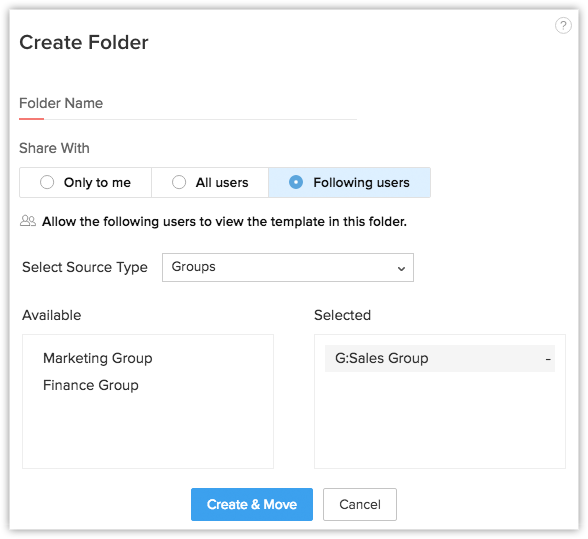
- A new folder will be created and the template will get added to it automatically.
Share Template Folders
You can share template folders with other users when needed. When you want to share only specific templates, you can add them to a folder and share them. This might be helpful in cases where the user does not have permission to create templates, but has to send them to customers.
- Click on the more options that appear when you hover the mouse over the template folder.
- Click on Share.

- In the Share Folders section, choose if you want to share the folder with All Users, Only to me or specify the users you want to share with.In case you chose to select specific users, you can select the source type from the drop-down list and select the users.
- Click Done.
Reorder Folders
You would prefer to have the important folders at the top of the list. In order to do that, you need to reorder the folders by clicking on Folders Reorder button. After reordering click Done.
There are ten instances in which you can make use of the email template. They are:
- Send Mail
- Mass Email
- Schedule Mass Email
- Auto Responders
- Macros
- Workflow Automation
- Approval Process
- Case Escalation
- Webforms
- Auto Response Rules
You can view a list of all the available email templates before sending them, in all the ten features. If you want, you can also mark a template as favorite from the list that appears.
You can also choose to view a preview of the template that you need before sending it. You get a consolidated view of the template analytics here. The percentage of Open rate, Click Rate and Bounce Rate for the different versions of the template are represented in the form of a chart.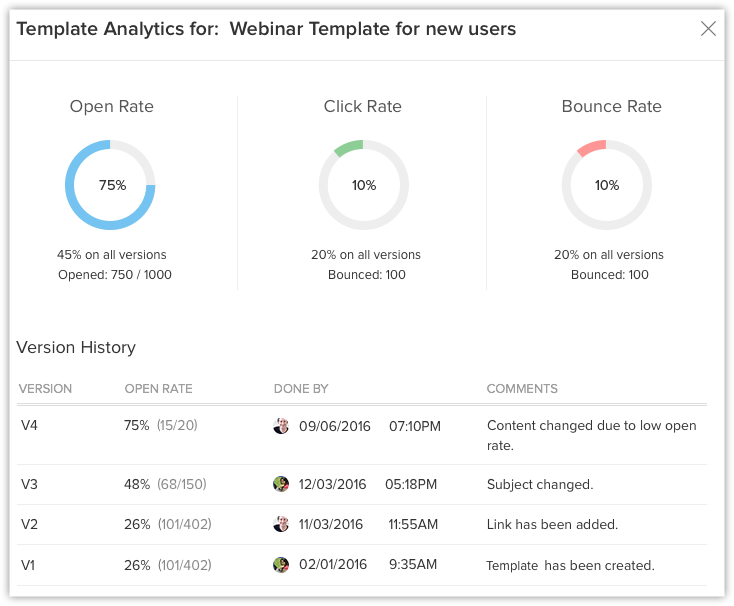
FAQ
1. Why is my signature not populated in the email messages that I send from Zoho CRM?
There are two ways of sending emails.
- You can send if from the Email tab (through Zoho Mail)
- You can send it from with a specific record (leads, Contacts etc.)
When you send it through the Email tab, the signature that you had added in Zoho Mail, will be populated in your email. Whereas, when you compose an email from within a lead or contact, the Zoho CRM signature will be populated.
Please ensure that you have the signature enabled for each mode of sending emails.
2. Can I include only the first name or last name in the email template?
Yes. If required, you can use only the first name or last name in the email template.
For example - You want to send an email where only the First Name of the contact needs to be mentioned. You need to follow the steps given below:
- Click Setup > Templates > EmailTemplates.
- Click the Edit link corresponding to the email template (for Contacts) that you want to edit.
- In the Edit Email Template page, do the following:
- Select Contacts from the Available Merge fields drop-down list.
- Select First Name field from the Select Field drop-down list.
- Copy the Merge Field${Contacts.First Name} and paste it in the body of the email template.
- Select Contacts from the Available Merge fields drop-down list.
- Click Save.
3. How can I set up unsubscribe form in my email templates?
You can use the unsubscription form to allow the email recipients to opt out from your next follow-up and avoid Anti-SPAM complaints. The process to set up the form consists of three steps:
Step 1 - Provide the Return URL and generate the HTML code for the form.
Step 2 - Use the HTML code to publish the form in the web page.
Step 3 - Provide the web page (where the unsubscription form is published) as a link in the email template.
Related Articles
Office365 Error: Unable to get SMTP email
During MS Outlook or Office 365 integration via IMAP-OAUTH or POP3-OAUTH protocols, if you encounter the following errors, please follow the respective steps to resolve them. Error: Unable to get SMTP email Steps 1. Log in to Microsoft 365 admin ...Re-assigning your email address to the correct Zoho CRM instance
Option 1: Deletes all Zoho services connected to your email address 1. Log into accounts.zoho.com (or accounts.zoho.eu depending on which server you're using) with your email address. 2. Click Preferences and select Close Account. This closes your ...Related List to Show Relevant Data from Other Modules
//Get Account Details accountMap = zoho.crm.getRecordById("Accounts",accountId); //Get account Variables contactList = zoho.crm.getRelatedRecords("Contacts","Accounts",accountId); // rowVal = 0; responseXML = ""; // if(contactList.size() > 1) { ...Sticky Notes in Zoho CRM
Sticky notes in Zoho CRM are a great way to quickly jot down details about a call, a task or any other information that needs to be easily accessible. These are personal notes and not visible to other users in your CRM account. Sticky notes are ...Zoho Desk - Edit other agents articles (solutions)
You can now enable 'Update/Delete All KB articles' permission, for non-admins as well. 'Setup > Users and Control > Permissions > Profiles' as shown in the screenshot attached below. However, this option would be accessible only for the portals where ...
